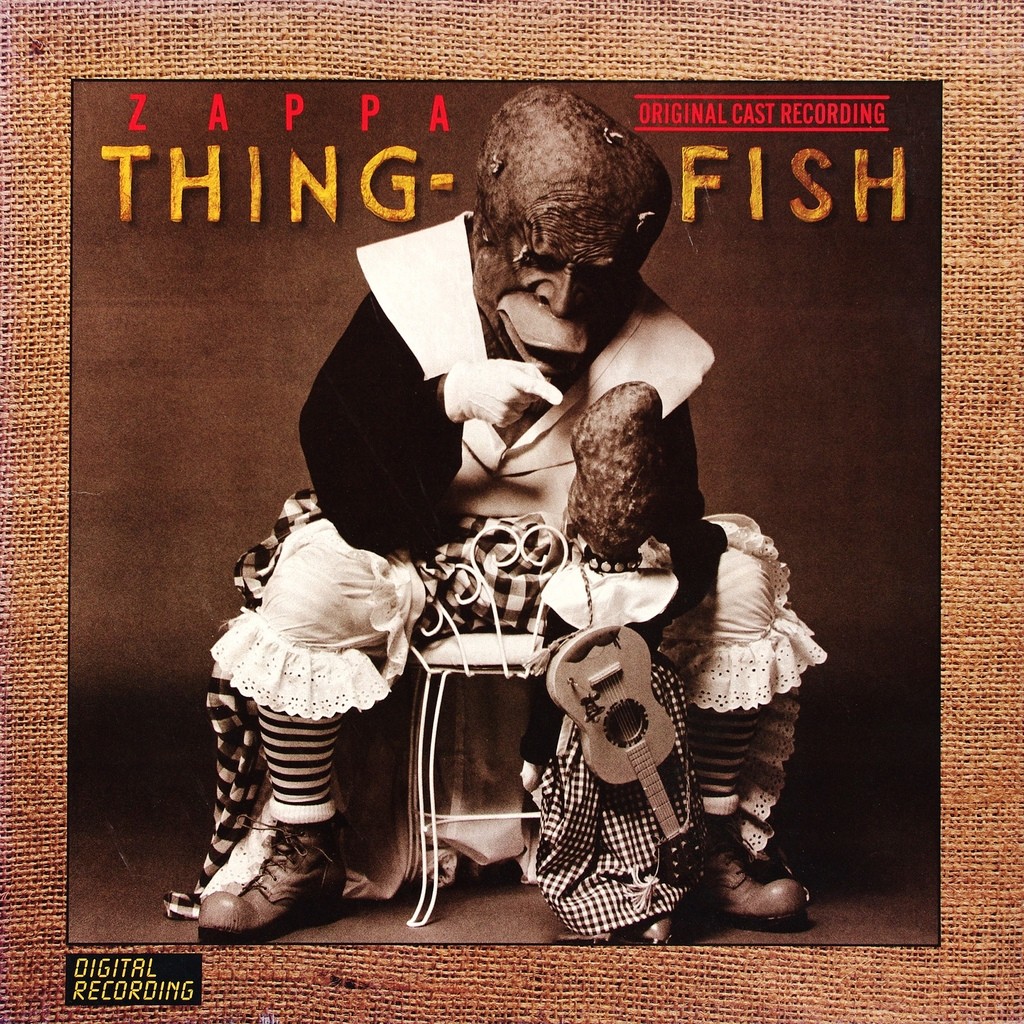PJ Harvey’s The Hope Six Demolition Project at first appears to be the distant and colder cousin of 2011’s anti-war masterpiece Let England Shake. Despite this initial impression, a deeper examination of Harvey’s motivations and approach – along with a comparison of her previous record – reveals more going on under the surface. Continue reading
Feature Articles
Mass Echoes & Dust Update 2
Here’s a bunch of things I’ve done written for Echoes & Dust over the last few months – including one of the best and most in-depth pieces I’ve ever written.
Echoes of the Past: Frank Zappa
I interview a series of musicians, from Zappa alumni like Robert (Bobby) Martin and Mike Keneally through to Thighpaulsandra, Matt Stevens and …probably too many others, asking them about what Zappa record they’d recommend as a starting point.
I talk with Kavus about the (then) upcoming Knifeworld tour, as well as Guapo, Gong, new music and raves.
This is the piece I’m most proud of – it also took me fucking forever to write. A look at the role of revolution in the music of Fela Kuti, as inspired by Albert Camus.
Review: The Display Team – Shifts
I review The Display Team’s latest record and all the crazy prog-punk insanity therein.
Echoes and Dust: Interview – The Residents
If my two part treatise on the band wasn’t evidence enough, I quite like The Residents. I’ll be seeing them live for the first time next month, but before then I was privileged to be given the opportunity to interview Homer Flynn of The Cryptic Corporation, manager and spokesperson for The Residents. We talk about some interesting potential projects that are coming up for the band, and Homer answers a few questions on things that have intrigued me over the years.
You can read the interview here: http://echoesanddust.com/2016/01/interview-the-residents/
Mass Echoes & Dust Update
It’s been a while since I posted here due to moving to London, but I have been busy! Here are the plethora of album reviews, gig reviews and interviews I’ve done since the move. Continue reading
The Crux of The Biscuit: Aural Conceptual Continuity in the Music of Frank Zappa
“Project/Object is a term I have used to describe the overall concept of my work in various mediums. Each project (in whatever realm), or interview connected to it, is part of a larger object, for which there is no ‘technical name.’
Think of the connecting material in the Project/Object this way: A novelist invents a character. If the character is a good one, he takes on a life of his own. Why should he get to go to only one party? He could pop up anytime in a future novel.”
“…In the case of the Project/Object, you may find a little poodle over here, a little blow job over there, etc., etc. I am not obsessed by poodles or blow jobs, however; these words (and others of equal insignificance), along with pictorial images and melodic themes, recur throughout the albums, interviews, films, videos (and this book) for no other reason than to unify the ‘collection.’”
– Frank Zappa with Peter Occhiogrosso, The Real Frank Zappa Book
“Like Mandelbrot’s fractals, every Zappa grotesquery springs from some tiny detail in previous work (the celebrated sex yarn ‘Dinah Moe-Humm’ was heralded by a phrase in the sci-fi story inside the booklet that accompanied Uncle Meat).”
– Ben Watson, Frank Zappa: The Complete Guide to His Music
“The official Zappa discography is often an unreliable indicator of chronology; therefore, one cannot necessarily assume that the composition of a given piece is concurrent with its first official release on an album.”
– Brett Clement, A Study of the Instrumental Music of Frank Zappa
tl;dr version: I made an interactive map of Frank Zappa’s conceptual continuity, and you can see it here.
“The Evil Prince” – The Heart and the Soul of Frank Zappa’s Thing-Fish
A somewhat in-depth analysis of Frank Zappa’s “The Evil Prince” from the 1984 album Thing-Fish.
February Album Writing In Retrospect
So part of what I spoke of in my update post is completed, with me completing February Album Writing Month (FAWM) for the 4th time. It’s a great way to break through any creative blocks you may be having, and just fun in general (albeit life-consuming fun). You can view all 16 tracks on the link above, but as that page will be wiped by the next February, I thought I’d chuck a few permanent links up for some of my favourite tracks I wrote. And a few vaguely related images to pretty it up a bit!
A Galoot Up-Date
No, all is not lost, In Disciplined still exists. The Project/Object I’m next working on is just taking…well it’s taking over my entire life. I cannot even escape the title of this update![1]
I’m currently attempting to map out the conceptual continuity of Frank Zappa’s work, focusing just on the music and lyrics (i.e. not liner notes or artwork, which would expand my job tenfold). What is conceptual continuity? I will most likely elaborate far more in the article itself, but just so you have some idea why don’t I hand you over to Frank Zappa himself:
“Project/Object is a term I have used to describe the overall concept of my work in various mediums. Each project (in whatever realm), or interview connected to it, is part of a larger object, for which there is no ‘technical name.’
Think of the connecting material in the Project/Object this way: A novelist invents a character. If the character is a good one, he takes on a life of his own. Why should he get to go to only one party? He could pop up anytime in a future novel.”
“…In the case of the Project/Object, you may find a little poodle over here, a little blow job over there, etc., etc. I am not obsessed by poodles or blow jobs, however; these words (and others of equal insignificance), along with pictorial images and melodic themes, recur throughout the albums, interviews, films, videos (and this book) for no other reason than to unify the ‘collection.’”
(p 139-140: The Real Frank Zappa Book by Frank Zappa with Peter Occhiogrosso 1989)
I’m also only listening to the 62-ish albums released when he was alive, although I am including Läther (which was compiled by Zappa as a 5 disc monster only to be rejected by Warner Bros.) and Civilization Phaze III (one of the last works Frank completed, but hadn’t released before his death). I’m a good chunk of the way there with 49 albums considered, but there’s still a ways to go!
In betwixt all of this, Montresor’s second album is on its way! I’ve just received the physical albums and they are looking splendid. I am currently auditioning drummers in order to get a few shows organised, ideally with a nice big album launch before I send this album off into the world.
I am also planning to partake in February Album Writing Month (or FAWM). I’ve done this I believe a total of 3 times in 5 years or so, and it’s always been a blast. Essentially, you have to write 14 songs in Feb (That’s a song every two days, dummy.) Some years I’ve completely smashed it out of the park and done 23 songs, other years it’s been tough going just getting to 14, but really it’s about just running headfirst through any writer’s block you may have and not stopping until you’ve collapsed from exhaustion. Creatively, that is.
So, that’s it for the moment! I leave you with some beautiful music that is currently playing as I type this. Take a wild guess at who it is?
[1] “Galoot Up-Date” being a track off the rather controversial 1984 Frank Zappa album Thing-Fish, and itself a reworking (or update) of “The Blue Light” from 1981’s Tinsel-Town Rebellion – see?! I cannot escape seeing links. I am basically John Nash. It’s only a matter of time before I am portrayed by Russell Crowe in a major motion picture.
Meaning in Retrospect: Artificial Trilogies and Bowie’s “Berlin Triptych”
The idea of dividing an artist into periods or eras is a very seductive one – preferring the ‘fusion years’ of Miles Davis over the ‘cool jazz’ of his beginnings, or Frank Zappa’s musique concrete over his more obscenity-riddled pop tunes in his later years. Although this is certainly a legitimate distinction in both examples given above, it is regardless something applied to the artist retrospectively. It’s fairly rare we ever hear the artist talking about their work in such strict, easily distinguished partitions. All the works bleed together; something that arose in one earlier piece of writing or music flourishes in the next and becomes the focus – the creation of a piece of art is far more complex and organic than these simple labels suggest.
Yet what about when these labels are applied by the artist? On the release of 1979’s Lodger, David Bowie announces this album to be the third part of a ‘triptych’ alongside 1977’s Low and “Heroes”. Brian Eno – Bowie’s musical collaborator over all three of these albums – also starts to refer these albums as a trilogy. The Berlin Triptych is born.
Just by calling these albums a collective whole, it definitively changes our experience of them as listeners. A trilogy perhaps even more so. We expect the first part (in this case, Low) to introduce us to ideas that will carry throughout the works, the second part (“Heroes”) to expand and experiment with these ideas, and the third (Lodger) to hark back to the original as well as providing us a sense of closure. A beginning, a middle and an end.
Bitch Degrees of Separation
The first jazz album I ever bought was Miles Davis’ Bitches Brew. As a jazz neophyte, it was a challenging listen. I saw 15+ minute tracks in the running order and thought this was something I had experience in, given my love of prog rock epics. How naive I was. The album is comprised of six improvised pieces of music with one or two themes being explored throughout; this requires a very different type of listening from what I was used to. Bass lines would loop for ten or so minutes at a time. Producer extraordinaire Teo Macero would perform some of the first instances of sampling by cutting and looping sections of improvised solos, morphing them into recurring melody lines.
The album’s opener is the Joe Zawinul-penned “Pharaoh’s Dance”. Zawinul’s keys flutter amongst drums, percussion and multiple bassists all playing simultaneously, with Bennie Maupin’s woodwinds and John McLaughlin’s guitar fleshing out this ethereal soundscape. And then Miles Davis’ trumpet enters a few minutes in, floating over the top of the mix and quickly gaining a passionate intensity. The music really does simmer like the album’s title implies, and I’ve always associated it since with summer music. The heat of the playing and the free-form nature of it all just made me want to lie back in the sun and chill, in spite of the music’s apparent chaos. It was nothing like anything else I had heard, and I wanted more.
But where would I look? The man with the trumpet had such an enormous back catalogue, that I was incredibly intimidated as where to go next. So I looked to players who I enjoyed from Bitches Brew. Jazz is typically a far more incestuous genre than rock, so tracking players and finding other albums they played on worked incredibly well as a way to get myself more exposure to this otherwise unknown genre to me. Of course, basing this search around Bitches Brew, considered the seminal jazz fusion record, meant the artists and albums I found typically dabbled in that genre. But pushing through I also discovered the beauty of hard bop and beyond.
Below is a chart I’ve made that’s quite personal. It tracks all the artists I’ve discovered that all link back to my first jazz album. These are just the albums I have that I can link back, so it’s far from a definitive list and I’m sure some of you will have plenty more (see: my incredibly small Coltrane collection). Others show artists I have plenty more albums by, but could find only one link with the albums I own (see: Mingus). I’m also not including albums I own, but haven’t really delved into properly yet (e.g. Shakti, Ornette Coleman). All the links are made from me referring to album liner notes or Wikipedia, and I’m hoping both are accurate.
Looking at the graph, it’s interesting how clear some of my obsessions are: Herbie Hancock’s gorgeous keyboard stylings lead to 15 albums (and one song – listed as such because I only have it on a best of compilation). But there were some surprising discoveries, like the relatively direct link from Weather Report to Swedish progressive death metallers Opeth. Anyway, here you have it: Bitch Degrees of Separation.
An interactive map of the graph is available here (FYI it seems a little temperamental in Chrome). Otherwise, click on the graph below for a closer look.







